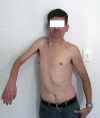Platysma motor branch transfer in brachial plexus repair: report of the first case
- PMID: 17474986
- PMCID: PMC1867811
- DOI: 10.1186/1749-7221-2-12
Platysma motor branch transfer in brachial plexus repair: report of the first case
Abstract
Background: Nerve transfers are commonly employed in the treatment of brachial plexus injuries. We report the use of a new donor for transfer, the platysma motor branch.
Methods: A patient with complete avulsion of the brachial plexus and phrenic nerve paralysis had the suprascapular nerve neurotized by the accessory nerve, half of the hypoglossal nerve transferred to the musculocutaneous nerve, and the platysma motor branch connected to the medial pectoral nerve.
Results: The diameter of both the platysma motor branch and the medial pectoral nerve was around 2 mm. Eight years after surgery, the patient recovered 45 degrees of abduction. Elbow flexion and shoulder adduction were rated as M4, according to the BMC. There was no deficit after the use of the above-mentioned nerves for transfer. Volitional control was acquired for independent function of elbow flexion and shoulder adduction.
Conclusion: The use of the platysma motor branch seems promising. This nerve is expendable; its section led to no deficits, and the relearning of motor control was not complicated. Further anatomical and clinical studies would help to clarify and confirm the usefulness of the platysma motor branch as a donor for nerve transfer.
Figures







References
-
- Chuang DCC. Neurotization procedures for brachial plexus injuries. Hand Clin. 1995;2:633–645. - PubMed
-
- Narakas AO. In: Microsurgery in orthopaedic practice. Leung PC, Gu YD, Ikuta Y, Narakas A, Landi A, Weiland AJ, editor. Singapore, World Scientific; 1995. Brachial plexus lesions; pp. 188–254.
-
- Cruveilhier J. Anatomie descriptive. Paris, Béchet Jeune, Tome IV; 1836. pp. 943–950.
Publication types
LinkOut - more resources
Full Text Sources
Other Literature Sources

